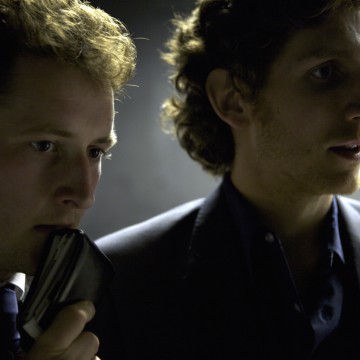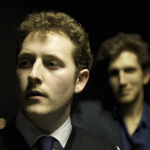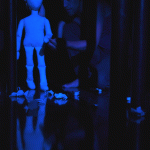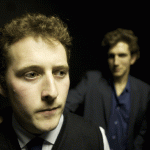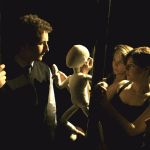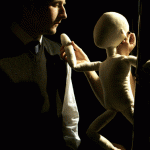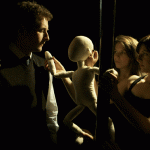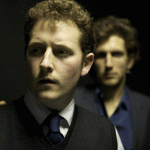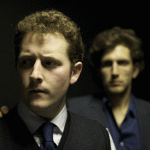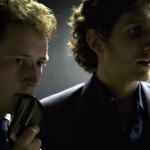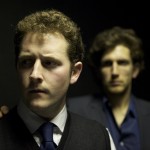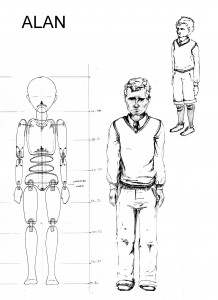by Phil King
Rough Fiction in association with South Hill Park at Underbelly, Edinburgh Festival 2006
Direction
★★★★ ‘Hugely Atmospheric … boldly original’ (British Theatre Guide)
★★★★ ‘the ensemble, uniformly excellent, push the boundaries between movement and the spoken word to create the disjointed otherworld of the play. The tension builds deftly, Pittman expertly controlling the pace of Philip King’s script until it’s almost unbearable’ What’s On Stage
Nowadays, whose word is truly their bond? Rough Fiction radically rework the famous Arthurian legend Sir Gawain and The Green Knight to come up with a modern-day morality tale that looks at just what we value and how far we will go to be happy. Fresh new writing, dark imagery, bold physicality and a six-strong professional ensemble. In a story of love, loss and brotherly rivalry Rough Fiction re-imagine this classic tale shedding new light on ancient values.
Reviews
★★★★ What’s On Stage, Saturday 22nd August 2009, by Corinne Furness
How far would you go to keep a promise? There’s something darkly thrilling about watching Killing Alan as its eponymous lead (Peter Stickney) walks into a wood, and into the very bottom of his psyche, to answer this very question.
An adaptation of the Arthurian legend Sir Gawain and the Green Knight, Killing Alan is a modern fable for adults. Brothers Alan and Dale haven’t spoken for ten years, but after the death of their parents, they’re brought back into contact. At a disastrous baptism, they make a pact that sends Alan on a quest and into the wood, where he’ll find out who he really is and what he really believes.
The first section, with the chimes of economic excess, meanders along pleasantly enough. It’s when we leave the recognisable England of 2009, however, that the production really hits its stride. In the hands of director Simon Pittman, this fairy-tale world jumps out of your childhood nightmares and onto the stage, starker, harsher and more terrifying than you ever could have dreamt.
There’s a real sense of imaginative possibility about Killing Alan that’s impossible not to embrace. Puppet Alans fill the wood (and Alan’s head) while the ensemble, uniformly excellent, push the boundaries between movement and the spoken word to create the disjointed otherworld of the play. The tension builds deftly, Pittman expertly controlling the pace of Philip King’s script until it’s almost unbearable to watch as Alan makes his final choice.
As a reminder of what happens when you go into the woods, Killing Alan is hard to beat.
★★★★ The British Theatre Guide, 14th August 2009, by Corinne Salisbury
Phil King’s new work, an old piece of folklore given a contemporary retelling, produces a wonderfully atmospheric and suspenseful show.
The tale of Sir Gawain and the Green Knight becomes the story of brothers Alan and Dale: they are reunited after ten years by the death of their parents, for which Alan holds Dale responsible. Shaken by the tragedy, Alan is spouting drunken rhetoric about becoming a man of action, and insisting that losing everything he had would only make him stronger. Dale decides to put this to the test, and in a heated altercation, invites Alan to stab him on the agreement that in a year’s time he can return the blow.
The main meat of the story then follows Alan a year later, wandering the woods in search of a brother with a knife blow waiting for him. But instead he meets a mysterious farmer with an estranged wife: Alan must visit the wife and then give the farmer whatever she gives him. Of course it turns out to be not exactly sponge cake. The “wife” gradually teaches Alan what courage is, and what it means to free yourself from yourself.
The play’s very interesting about the possibility of heroism and self-sacrifice in today’s world, and the idea of a person’s character being tested – something most of us rarely experience. It also cleverly develops Alan’s attitude to women: on his initial hero trip he dismisses them as “dithering nay-sayers” but in the end it’s a woman that transforms him. The journey through the wilderness is nicely staged, and puppets – the creepiest I have seen yet – are well used: figments of Alan’s imagination whispering his own doubts into his ear. It’s a boldly original piece of work: fantastical, but concerned really with the monsters in our minds.
★★★★ Three Weeks, 26th August 2009, by Ajantha Chandrasena
An Arthurian legend re-spun as a modern-day morality tale, ‘Killing Alan’ is topical, poignant and compelling. We meet Alan on the day of his parents’ funeral, where he makes glibly epiphanic claims of new-found immaterialism and blames his estranged older brother for his parents’ death. Unbeknown to him, his sibling has been watching and confronts him; a few bad decisions later, Alan is thrown down a path of self-exploration, challenging the ideas of worth, loss and existence along the way. Brilliantly brought to life by the production, which exploits striking physicality and innovative stagecraft to great effect, the professional cast give a first-rate performance. Polished and provocative, ‘Killing Alan’ leads us on a journey we all must travel.
★★★★ Fest, Monday 17th August 2009, by Lewis Porteous
Only two scenes into Killing Alan, alarm bells go off among the audience. The play, purportedly a “radical reworking” of the legend of Sir Gawain and the Green Knight, appears to have reinvented its source material through the lazy means of simply transplanting it to the present. The six-strong cast are introduced as affluent socialites, hanging out in what appears to be a grand function room, following both the baptism of their friends’ child and the funeral of the protagonist’s parents. It’s a potentially sterile set-up but the Rough Fiction production demonstrates great savvy in dodging the trap.
The play’s narrative sees Alan, a modern Gawain, accept an offer from the brother whom he blames for their parents’ demise, on the condition that the victim may stab him in retaliation a year later. The wound does not prove fatal and as Alan departs, fearing for his life, he is forced to put his emotionally insubstantial existence into perspective.
Aspects of the original tale, such as the disguise donned by the Green Knight, prove resistant to modernisation – yet this works to the play’s thematic benefit, flitting as it does from gritty realism to pastoral fantasia. If the world Alan first inhabits seems dramatically lifeless and staid, this notion is reinforced emotionally as the play’s actions unfold, with the character eventually eschewing his materialistic life.
Though the “bold physicality” promised by the play amounts to little more than the sight of two men kissing, the cast handle their multiple roles with aplomb, throwing themselves into an audacious work which is confident, poetic and deeply accessible.
★★★★ Broadway Baby, Wednesday 19th August 2009, by Leon Conrad “Breathing New Life into an Arthurian Legend”
A highly challenging story which draws on the Arthurian story of Gawain and the Green Knight, and references many others. The central character, Alan, is challenged to a game by his brother after the death of their parents. Sibling rivalry emerges, which pushes both of them to the limits of acceptable behaviour and beyond. As others look on, Alan is challenged to stab his brother in a scene which deliberately references the story of Cain and Abel. The brother survives and orders him to meet him in a year’s time to receive a reciprocal blow which his brother says will kill him. Time passes and Alan travels to the appointed place. He has three days to wait. The story flows on. The blow falls. Blood is shed. The play ends.
Rough Fiction and South Hill Park, the team behind this production bring the varied skills of acting and puppetry together in this work. The puppets are manipulated expertly and are used to reflect Alan’s inner voice(s). It is an effective theatrical device. The ensemble work within the company is strong, enabling quick scene and costume changes to happen onstage with the minimum of fuss and maximum effect.
Credits
Cast – Stewart Burgess, Charlie Cattrall, Rob Cavazos, Stephanie Farrell, Peter Stickney, Beth Wignall
Playwright – Phil King
Director – Simon Pittman
Designer – Louie Whitemore
Lighting Designer – Tim Deiling
Composer / Sound Designer – Jonnie Harrison
Assistant Designer – Kasper Svenstrup Hansen
Associate Producer – Mimi Poskitt
Company Stage Manager – Eve Rowley
Casting Director – Annelie Powell
Producing Assistant – Alex Turner
Puppet Fabricators – Mark Aspey, Daniel Gomer, Yukino Kobayashi, Thomas Lowthion, Shelly Ng, Isabelle Riley
Graphic Design – Tom Munckton
Press Photography – Christian McLaughlin
Original Production Image – Anthony Goicolea
Special thanks to both Dan Jones for their help in the last moments.
Thank you to South Hill Park, Theatre 503, Tara Arts, Jermyn Street Theatre, Lyric Hammersmith, Granville Arts, Royal Holloway University and London Metropolitan University for their support.

